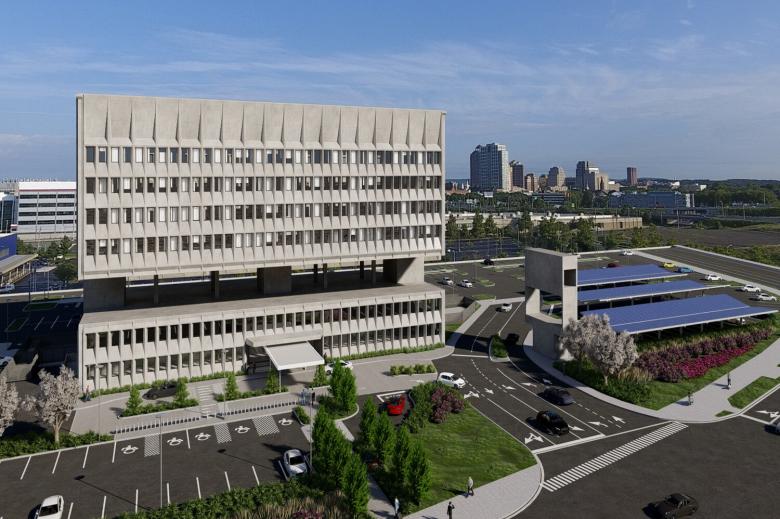US Building of the Week
Hotel Marcel
Becker + Becker
11. October 2021
Photo: Bruce Redman Becker, FAIA
On July 28, 2004, IKEA opened a new store in New Haven, Connecticut, a store that controversially cut up Marcel Breuer's 50-year-old Pirelli Building. A decade and a half later, architect and developer Bruce Redman Becker bought the empty office building, with plans to convert it into a hotel. Becker answered some questions about the adaptive-reuse project set to open next year as the Hilton-branded Hotel Marcel.
Location: 500 Sargent Drive, New Haven, Connecticut, USA
Client: Becker + Becker
Architect: Becker + Becker
- Design Principal: Bruce Redman Becker, FAIA
- Project Architect: Violette de La Selle
- Project Manager: Vivie Lee
- Project Team: Alice Tai, Michelle Lauterwasser
Structural Engineer: GNCB
MEP/FP Engineer: LN Consulting
Landscape Architect: Blades Goven
Lighting Designer: Focus Lighting
Interior Designer: Dutch East Design
Construction Manager: Consigli Construction
Interior Demolition and Abatement: Babbidge Construction
Site Area: 1.8 acres
Building Area: 110,000 sf
Rendering from the east. (Visualization: Becker + Becker)
What were the circumstances of receiving the commission for this project?The project was initiated by Becker + Becker as an integrated architecture, planning and development firm.
The project is the adaptive reuse of the mid-century-modern former Armstrong Rubber Company Building, designed by Marcel Breuer in 1969, into a new, 165-room boutique hotel and conference center that will be the first net zero-energy hotel in the United States.
Rendering from the north. (Visualization: Becker + Becker)
What are the main ideas and inspirations influencing the design of the project?Historic Preservation of an iconic brutalist building; new interiors inspired by Bauhaus principles; an emphasis on sustainable and Passive House design; and using no fossil fuels to create a net zero-energy hotel.
The adaptive reuse design was guided by the existing building's five-foot module as an organizing element, and existing elements such as light fixtures and door frames are recycled and reused. The inherent passive solar character of deep-set windows is developed as part of a fully certified Passive House design.
Photo: Becker + Becker
How did the project change between the initial design stage and its completion?A one-megawatt-hour battery was added so that the building can remain in operation as an off-grid mode with true renewable micro-grid capability. Design features were refined and added to meet Hilton brand standards and to enhance sustainability, with kitchen and laundry having all electric appliances and the elimination of a natural gas connection to the building.
The building will meet LEED Platinum, Passive House, net zero-energy certification standards.
Rendering of reception. (Visualization: Dutch East Design)
What products or materials have contributed to the success of the completed project?Locally-sourced millwork and case goods, high-performance solar panels, and Power over Ethernet (POE) LED lighting systems throughout.
- Casegoods – The New Traditionalists
- POE Lighting Design and Installation – Sinclair Digital
- Windows - Klar
- Solar Panels - SunPower
Email interview conducted by John Hill.
Rendering of bar/dining. (Visualization: Dutch East Design)
Related articles
-
Views from the Top
1 month ago
-
The Vessel Reopens with Safety Netting
1 month ago
-
NYC Opens Up
1 month ago
-
Tākina – Wellington Convention and Exhibition Centre
2 months ago





